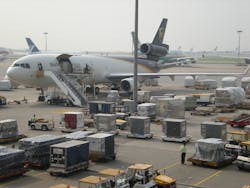Jan. 21, 2020, marked 50 years since the first commercial flight of the mighty Boeing 747, from New York to London. No doubt this newsworthy anniversary of an event which has probably changed all our lives, ushering in as it did an amazing era for civil aviation, will receive a good degree of coverage.
Less newsworthy, but of equal significance, is that this date marks the first use of unit load devices (ULDs) onboard passenger aircraft. Prior to this historic date ULDs were only found on narrow-body freighters.
Those 50 years of ULDs are an unescapable part of the DNA of airline and air cargo operations, facilitating as they do the daily movement of tens of thousands of passenger bags and tons of cargo through fast and labor-light aircraft loading/unloading operations, off-airport build-up and intermodal transport and specialist cargo, such as race horses and pharmaceuticals.
Yes, there is no question, the roughly 900,000 ULDs in service between the world’s airlines contribute enormous value to efficient airline and air cargo operations.
However, there is a flip-side to this glowing description of ULDs, which is that as the industry has grown over 50 years ULDs often find themselves being stored, transported and used in a less-than-appropriate manner, leading to some unsatisfactory outcomes.
Outcome 1: The first and foremost purpose of any ULD, once on the aircraft, is to provide a defined level of restraint during normal and abnormal flight conditions. This is, indeed, the first and foremost requirement of any ULD – failure to perform this function when needed can, and indeed has, led to severe damage to aircraft, including crashing. Unbeknownst to probably most people who work with and around ULDs, this box or pallet is in fact a part of the aircraft’s flight safety process and is subject to the same level of regulatory oversight as any other part of the aircraft.
Outcome 2: Since that first 747 flight 50 years ago, airlines have to a great extent outsourced their ground handling and cargo operations to third-party organizations, which range from multi-location giants to single-station/single-airline minnows. And here is the kicker, while airlines operate within a highly regulated safety environment, the ground handling community is generally not subject to the same level of direct safety regulation.
Outcome 3: It is no secret that airports are often crowded places. Yes, there are some wonderful, shiny, new airports with acres of space, but all too often ground ops are carried out in very congested conditions – a situation made worse by the larger and larger number of ULDs carried on today’s aircraft. The 777-8x, which is about to enter service, will carry almost 10 percent more ULDs than its earlier models, and indeed, just the forward holds of A350 XWBs and 787s carry more ULDs than the first generation 747 in all holds. This “stealth growth” in the number of ULDs arriving and departing on each aircraft places an ever-increasing challenge on the ground.
Outcome 4: It is also no secret that the handling and cargo industries face enormous challenges to hire and retain staff, meaning that all too often that person building up or moving a ULD that is about to transport maybe 10,000 kilometers on a $200 million (USD) aircraft has a negligible understanding that this container or pallet they are working with is about to perform a flight safety function.
Airlines have, to a greater or lesser extent, wrestled with these outcomes for 15 years now. Probably the first “wake up” call came in 2005 when the Federal Aviation Administration (FAA) in the U.S. published their AC 120-85 “Air Cargo Operations” as a result of the Fine Air Flight 101 in 1997. Spelling out in plain language and considerable detail, this Advisory Circular provides one, but not the only, manner in which airlines can conduct compliant cargo operations. ULDs are mentioned more than 150 times, reflecting the regulatory expectations, at least of the FAA, for ULD operations.
The AC 120-85 was a “cold bath” for a number of airlines who found themselves on the wrong end of spot audits across the U.S., with the FAA having the authority to carry out checks on any aircraft landing on U.S. soil. ULD managers scrambled to ensure that only serviceable, properly built up ULDs were loaded to the aircraft, but with one hand tied behind their backs as these safety critical functions are almost entirely carried out by outsourced vendors. However, much money was thrown at buying new ULDs and cargo nets, and repairing both time and time again real-life operational standards of ULDs remained unacceptably below par.
While individual airlines did their best to address this, there is little one airline can do to change the culture at a service provider handling multiple airlines. Perhaps it was possible to make a difference at home base, but at locations half way around the world, driving change was close to impossible.
In 2010, IATA picked up some slack with an enhanced focus on ULDs, leading to the publication of the IATA ULD Regulations in January 2013, and providing for the first time a comprehensive reference guide to ULDs for the industry. Enhanced training courses and other support materials followed.
Meanwhile over at ULD CARE, the “club” for ULD owners, operators and providers, a 10-minute video “SOS ULD” communicating the flight safety function of ULD was produced as a vehicle to reach out to the entire industry, and this was followed a couple of years later by the publication of ULD CARE’s “ULD Explained” – an easy-to-read “how to” on ULDs.
Enter stage left the ULD CARE ULD Code of Conduct. Search “code of conduct” online and you will get 776 million hits. Codes of conduct are widely used across many industries as a means of establishing a set of expectations for any particular activity. Codes of conduct, however, are not so common in aviation, where the level of external regulation by the International Civil Aviation Organization (ICAO) and the national aviation authorities is more than sufficient to police the industry. So why a code of conduct for ULDs?
As laid out earlier in this column, the actual handling of ULDs is rarely performed by highly regulated airlines, falling instead to generally unregulated service providers. The ULD Code of Conduct crystallizes the key aspects of ULD operations.
A code of conduct coming from a community organization such as ULD CARE carries a greater weight than the action of any one airline – however large they may be.
While being both voluntary and non-binding, the ULD Code of Conduct sets a foundation for both airlines and service providers to aim for. Nobody has expectations of a perfect world where each and every ULD is always stored, transported and operated perfectly. Of course, bad stuff will happen, but with a code of conduct in place, there is a chance to review such failings in an objective manner.
The code itself comprises of 1+10 specific expectations. The “one” is that airlines/ULD providers shall provide ULDs that are “fit for purpose,” while the “ten” are the requirements for those organizations doing the day-to-day ULD operations. All are based on the content of the IATA ULD Regulations, and “behind” each line on the website are links to extensive supporting material. Online sign-up by any related organization is free and there are no audits or other checks – as with many codes of conduct, compliance is the sole responsibility of the participant.
Following a soft launch in 2017 and a hard launch in 2018, the list of sign-ups is growing – recent additions being Menzies Aviation and Hactl, with others are in the pipeline.
These are exciting times for the ULD community, with some really interesting technology innovations coming into play that can finally provide ULD owners and operators with a far closer visibility of both the location and condition of their ULD assets.
Fifty years on these are very welcome developments, which if they live up to expectations will drive an increase in attributable responsibility for the condition of ULD assets, putting the ULD CARE ULD Code of Conduct firmly in the spotlight.
Bob Rogers has spent most of his working life in Asia Pacific, resident in Hong Kong and for many years running the Asia Pacific operation of Nordisk Aviation Products. Mostly retired from a demanding “day job” these days he remains actively involved in promoting and supporting a wider understanding of ULD through his involvement with IATA and ULD CARE.
About the Author

Bob Rogers
Bob Rogers has spent most of his working life in Asia Pacific, resident in Hong Kong and for many years running the Asia Pacific operation of Nordisk Aviation Products. Mostly retired from a demanding “ day job” these days he remains actively involved in promoting and supporting a wider understanding of ULD through his involvement with IATA and ULD CARE.
